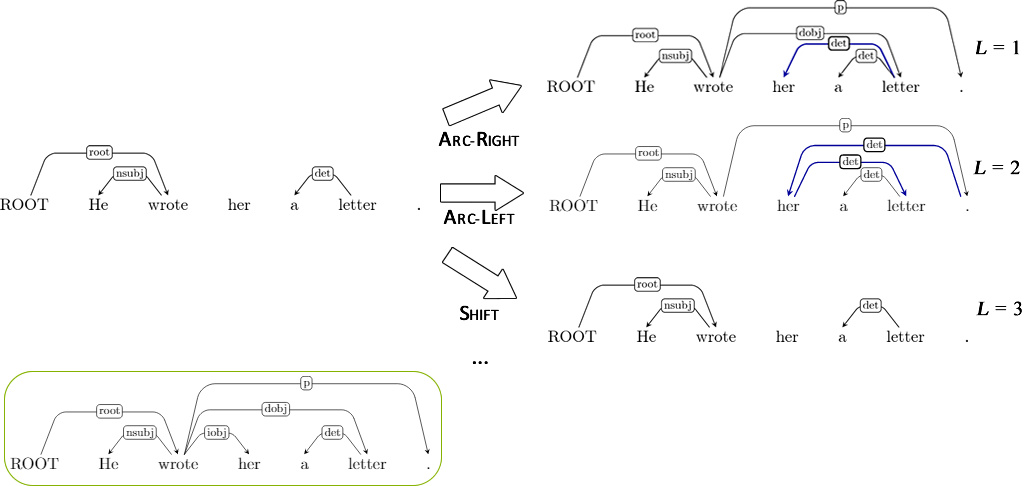Practical advice
Making sure everything actually works!
Is the expert policy working as intended?¶
Perform full rollins with $\pi^{\star}$.
- Resulting sequences should have $L(S_{final}, \mathbf{y}) = 0$.
- Or close to 0, if happy with suboptimal $\pi^{\star}$.

If expert policy takes too long to calculate during rollout:
- Consider suboptimal alternatives!
- More IL iterations could be more helpful.
Are the roll-outs working as intended?¶
Ensure costs obtained through rollouts are sensible.
- Actions returned by optimal $\pi^{\star}$ should have low cost.
- Equally optimal actions should be costed closely.

If loss rises:
- Adjust transition system.
- Make sure features (latent representations) describe the state and actions adequately.
Avoid cycles¶
Need to prevent cycles between state transitions!
... -> Swap($e_i$, $e_j$) -> Swap($e_j$, $e_i$) -> ...</ul>
Cycles can be controlled in either:
- Transition system, or
- loss function.
Identify problems in your task¶
Suboptimal expert policy?
- Use rollouts that mix expert and classifier.
Errors in rollin introducing noise to the feature vectors?
- Try sequence correction.
Too many actions to rollout?
- Try targeted exploration.
Irrelevant errors in rollouts affect costing?
- Try focused costing.
Noisy training instances?
- Try $a$-bound noise reduction.
Summary¶
Discussed expert policy definitions:
- Static vs. dynamic vs. suboptimal policies.
Examined variations to exploration:
- Early termination, and targeted and partial exploration.
Showed how we can reduce noise in the transition sequence.
- $\alpha$-bound and focused costing.
Applying Imitation Learning on various NLP tasks.
- Transitions, loss functions, expert policies.
- And improved on results!
Annotated bibliography¶
PhD theses¶
Hal Daumé III, 2006: Practical Structured Learning Techniques for Natural Language Processing
Stéphane Ross, 2013: Interactive Learning for Sequential Decisions and Predictions
Pieter Abbeel, 2008: Apprenticeship Learning and Reinforcement Learning with Application to Robotic Control
Papers¶
Abeel and Ng, 2004: Apprenticeship Learning via Inverse Reinforcement Learning (inverse reinforcement learning)
Viera and Eisner, 2016: Learning to Prune: Exploring the Frontier of Fast and Accurate Parsing (LOLS with random expert=RL, changeprop)
Goldberg and Nivre, 2012: A Dynamic Oracle for Arc-Eager Dependency Parsing (DAgger for dependency parsing)
Ballesteros et al., 2016: Training with Exploration Improves a Greedy Stack LSTM Parser (DAgger for LSTM-based dependency parsing)
Clark and Manning, 2015: Entity-Centric Coreference Resolution with Model Stacking
Papers¶
Lampouras and Vlachos 2016: Imitation learning for language generation from unaligned data (LoLS for natural language generation, sequence correction).
Goodman et al. 2016: Noise reduction and targeted exploration in imitation learning for Abstract Meaning Representation parsing (V-DAgger for semantic parsing, targeted exploration).
Vlachos and Craven, 2011: Search-based Structured Prediction applied to Biomedical Event Extraction (SEARN for biomedical event extraction, focused costing)
Berant and Liang, 2015: Imitation Learning of Agenda-based Semantic Parsers
Ranzato et al., 2016: Sequence Level Training with Recurrent Neural Networks (Imitation learning for RNNs, learns a cost estimator instead of using roll-outs)
Papers¶
Daumé III et al., 2009: Search-based structured prediction (SEARN algorithm)
Daumé III, 2009: Unsupervised Search-based Structured Prediction (Unsupervised structured prediction with SEARN)
Chang et al., 2015: Learning to search better than your teacher (LoLS algorithm, connection with RL)
Ho and Ermon, 2016: Generative Adversarial Imitation Learning (Connection with adversarial training)
He et al., 2012: Imitation Learning by Coaching (coaching for DAgger)
